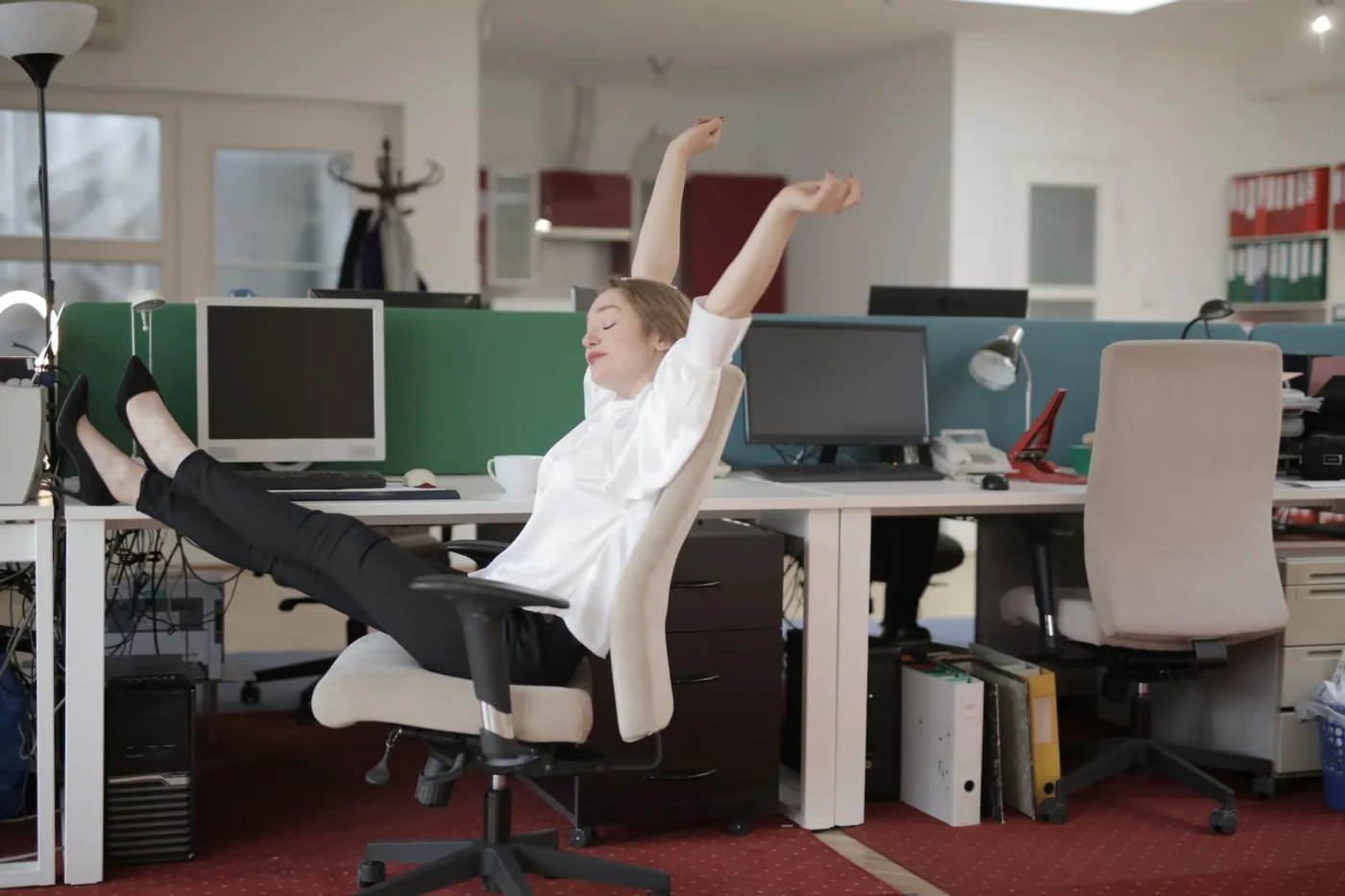Sitting at a desk for long hours can be hard on your body. It’s not just about bad posture—it can make you feel tired, stiff, and achy. Staying in one position too long can tighten your muscles and slow your blood flow. Over time, this can cause back pain and other problems. That’s why Desk Worker Stretches during the day is so helpful. It loosens tight muscles, improves blood flow, and gives you more energy. Even a few minutes of stretching can make you feel better. It’s a simple way to stay comfortable and healthy while you work. Small changes like this can make a big difference.
The Toll of the Desk Job

Sitting too long makes some muscles tight and others weak. For example, muscles that help us bend our hips get tight, causing back pain. Muscles in our core and back that help with posture get weak. This can cause slouching, a forward head, and a higher chance of getting hurt. Even simple movements like walking or standing can feel uncomfortable.
Sitting also slows blood flow, so muscles don’t get enough oxygen and nutrients. This can make you feel stiff, tired, and sore. The afternoon tiredness many Desk Worker Stretches feel is caused by poor blood flow. Over time, this can also affect your heart.
Beyond the Standing Desk: Why Movement Matters
Standing desks can help reduce sitting, but they aren’t enough on their own. Standing for too long can hurt your legs and back. The best way to stay comfortable is by moving and stretching regularly. Change positions often, take short walks, and do stretches to help fix muscle imbalances from sitting. These simple changes can help you feel better and improve your posture. Stretching can relax tight muscles, and moving keeps your body active. A mix of standing, moving, and stretching is the best way to stay comfortable during long hours at your desk.
The Science of Movement That Actually Works

Taking regular breaks to move is helpful, but it’s also important to know why some stretches work better for Desk Worker Stretches. Many of us feel relief when a stretch targets the right spot, but others don’t seem to help much. This happens because sitting at a desk affects our muscles in certain ways, making them tight or weak over time. Some stretches focus on these problem areas to ease tension and improve posture. Understanding how your body reacts to sitting helps you pick the right stretches. This can help you feel better and keep your muscles in balance.
Targeting Desk-Specific Tension
Sitting for too long makes some muscles tight, like the hip flexors, and weakens the core. Our shoulders also tend to roll forward. That’s why desk stretches should focus on these areas. Stretching the hips, strengthening the core, and pulling the shoulders back can help. Doing these stretches can improve your posture, reduce back pain, and give you more energy. Regularly stretching helps you feel better when sitting for long times. It’s an easy way to stay comfortable and reduce tension.
Why Timing Matters for Desk Worker Stretches
When you stretch is just as important as stretching regularly. Our bodies follow natural rhythms that help us get better results. For example, stretching in the morning helps get blood flowing and reduces stiffness. But it’s even better to stretch a little bit throughout the day. A few minutes of stretching each hour is more helpful than one long session after work. This stops tension from building up. Stretching often helps keep your body moving and feeling good. It’s a simple way to stay comfortable and avoid stiffness.
Muscle Memory and the Power of Repetition
Just like learning a new skill, our muscles develop habits from doing the same actions or not moving enough. This is why regular stretching is so important for desk workers. Stretching tight muscles and using muscles that don’t get much work helps your body improve its posture and movements. Some stretches might give you quick relief because your body is used to them. But changing bad posture habits takes time and regular practice, like learning a new skill. With patience, your muscles will get used to better habits, and you’ll feel less discomfort. Stretching regularly helps your body reset. Over time, you’ll see better posture and more comfort.
Beyond Basic Stretches: Understanding Your Body
Moving is always better than staying still, but understanding the science behind stretching helps you create more effective routines. Pay attention to how your body feels – which stretches give you the most relief? Where do you feel tight or sore the most? By listening to these signals, you can adjust your routine to focus on the areas that need it most. This awareness helps you go beyond general advice and build a stretching routine that works for your body and needs. Everyone’s body is different, so customizing your routine can lead to better results. Over time, you’ll see improvements in flexibility and comfort.
Your Morning Movement Blueprint

A few minutes of stretching in the morning can make a big difference in how you feel during your workday. These simple stretches get your body ready for sitting at a desk and help keep you healthy. You can easily add stretches to your morning routine without taking up much time. Stretching helps reduce stiffness and makes you feel more flexible. It’s a quick way to feel better and more comfortable as you work. Doing this regularly can stop discomfort later in the day. Stretching in the morning helps you stay energized. It’s a simple habit that makes workdays easier. Just a few minutes can help you feel better all day.
Why Morning Stretches Matter
When you wake up, your body is stiff and needs movement. Morning stretches help get your blood flowing, loosen tight muscles, and give you energy. Like athletes warm up, office Desk Worker Stretches before sitting. Simple stretches can help loosen tight hips and improve posture. Stretching in the morning helps prevent pain later. It’s an easy way to feel better and stay flexible. A quick stretch can make a big difference. It helps you feel comfortable all day. Stretching is a small habit with big rewards.
Making It a Habit
Starting new habits can be hard, but small changes can help. You can set a reminder or stretch while your coffee brews. Apps like Moova give you 3-minute movement breaks. Even a few stretches are better than none. When you feel better with regular movement, it will become part of your routine. Short stretches help reduce stiffness, improve blood flow, and give you more energy. This helps you feel better and work better. Just a few minutes of movement can make a big difference.
Desk-Friendly Stretches That Don’t Draw Attention

You don’t need to make a scene to stay active at work. Simple stretches and small movements can have a big impact, even in a busy office. According to the U.S. Bureau of Labor Statistics, half of workers who sit for long periods each day deal with stiffness and pain. Fortunately, there are easy stretches you can do right at your desk to help with this. These moves won’t attract attention, but they can really improve how you feel. Adding small amounts of movement can reduce discomfort and help you stay focused. You don’t need to leave your desk to make a difference. Let’s explore some simple stretches you can do during your day.
Seated Spinal Twists
If you’re on a long phone call and need to stretch your back, try this easy twist. Sit up straight and slowly turn your body to one side, putting your hand on the opposite knee or armrest for support. Hold for 15-20 seconds while breathing deeply. This stretch helps keep your back flexible when sitting for a long time. Switch sides to keep your body balanced. The best part is you can do it without getting up from your chair. It’s a simple way to feel better during your day. Doing this stretch often can help reduce back pain and improve posture.
Subtle Shoulder Blade Squeezes
When you feel tension in your shoulders, try this simple exercise to relieve it. Sit up straight and gently squeeze your shoulder blades together, as if you’re holding a pencil between them. Hold this position for 5-10 seconds, then release. You can repeat this movement several times throughout the day. It helps strengthen the muscles in your back and improves posture, especially if you tend to hunch forward from sitting at a desk. The best part is that this exercise looks like a natural adjustment, so you can do it anytime, even during meetings. It’s a quick and effective way to reduce shoulder tension and support your posture.
Wrist and Hand Stretches
Using a computer for too long can make your hands and wrists hurt, but easy stretches can help. Stretch one arm with your palm up. Use your other hand to gently pull your fingers back. Hold for 15-20 seconds, then switch arms. This stretch helps loosen tight forearm muscles from typing and using the mouse. Another stretch is making a fist, then opening your fingers wide. This helps your hands stay flexible and improves blood flow. Stretching often can stop hand and wrist pain.
Neck Tilts and Rotations
For common neck aches, try these gentle stretches during your day. Slowly tilt your head to one side, bringing your ear toward your shoulder. Hold for 15-20 seconds, then switch to the other side. This helps relieve tension in the neck muscles from long screen time. You can also do slow head circles in both directions to improve movement. These simple stretches can be done easily at work and help you maintain good posture while preventing pain. Make these stretches a daily habit for the best results. Regular stretching keeps your body feeling good throughout your workday.
Building Your Personal Movement Strategy
Sitting all day can affect your body in different ways, so it’s important to find movements that help you. To feel better at work, focus on stretches that suit your body. Pay attention to where you feel tight, like your back, neck, or legs, and stretch those areas. Take regular breaks to move, like walking or stretching. Choose stretches that work for you, not just the usual advice. Listen to your body and change your routine if needed. This will help you feel more comfortable during the day. A routine that fits you makes a big difference at work.
Analyzing Your Work Patterns and Body’s Needs
Think about how you spend your workday. Do you sit for a long time without moving, or do you get to move around? Notice where you feel tightness – maybe your hips from sitting, your neck from using the computer, or your wrists from typing. If you’re on video calls a lot, your stretches will be different than if you’re coding all day. Understanding your daily routine helps you pick stretches that focus on your problem areas. Knowing where the tension builds makes it easier to stretch the right muscles.
Creating a Sustainable Routine
It can be hard to find time to move during busy workdays, but being consistent helps. Instead of trying one long session, break it into small parts throughout the day. Even on busy days, you can take a minute or two each hour for a quick neck roll, shoulder stretch, or wrist exercise. These short breaks stop tension from building up and are easier than longer sessions. Doing small movements regularly helps your body stay comfortable and avoid stiffness. A few quick stretches can make a big difference in how you feel. They help you stay relaxed and focused.
Triggers and Tools for Consistent Practice
Building new habits takes some planning, but it’s not too hard. Setting phone reminders can help you remember to take movement breaks. Moova offers 3-minute guided sessions with different exercises to keep you on track. These short sessions make it easy to stay consistent. With expert help, you can do the right exercises and focus on the muscles that need it most. Clear reminders and good tools make movement part of your day, not a chore. It becomes a simple routine, helping you avoid discomfort and stay active while working.
Adapting to Changing Work Demands
Your schedule changes every day, so your movement should change too. Some days, you can take longer breaks, while on busy days, quick stretches work best. On deadline days, do simple desk exercises. When it’s calmer, take walks or do longer stretches. Being flexible helps you stay active even during busy times.
To make movement part of your day, know what works for you, make simple routines, and use helpful tools. Adjust when needed to avoid pain. The goal is to make Desk Worker Stretches a normal part of your day, not just when you feel sore. Regular movement will help you feel better and stay focused.



1 Comment